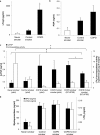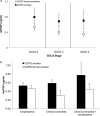An aberrant leukotriene A4 hydrolase-proline-glycine-proline pathway in the pathogenesis of chronic obstructive pulmonary disease
- PMID: 24874071
- PMCID: PMC4226028
- DOI: 10.1164/rccm.201401-0145OC
An aberrant leukotriene A4 hydrolase-proline-glycine-proline pathway in the pathogenesis of chronic obstructive pulmonary disease
Abstract
Rationale: Chronic neutrophilic inflammation is a hallmark in the pathogenesis of chronic obstructive pulmonary disease (COPD) and persists after cigarette smoking has stopped. Mechanisms involved in this ongoing inflammatory response have not been delineated.
Objectives: We investigated changes to the leukotriene A4 hydrolase (LTA4H)-proline-glycine-proline (PGP) pathway and chronic inflammation in the development of COPD.
Methods: A/J mice were exposed to air or cigarette smoke for 22 weeks followed by bronchoalveolar lavage and lung and cardiac tissue analysis. Two human cohorts were used to analyze changes to the LTA4H-PGP pathway in never smokers, control smokers, COPD smokers, and COPD former smokers. PGP/AcPGP and LTA4H aminopeptidase activity were detected by mass spectroscopy, LTA4H amounts were detected by ELISA, and acrolein was detected by Western blot.
Measurements and main results: Mice exposed to cigarette smoke developed emphysema with increased PGP, neutrophilic inflammation, and selective inhibition of LTA4H aminopeptidase, which ordinarily degrades PGP. We recapitulated these findings in smokers with and without COPD. PGP and AcPGP are closely associated with cigarette smoke use. Once chronic inflammation is established, changes to LTA4H aminopeptidase remain, even in the absence of ongoing cigarette use. Acrolein modifies LTA4H and inhibits aminopeptidase activity to the same extent as cigarette smoke.
Conclusions: These results demonstrate a novel pathway of aberrant regulation of PGP/AcPGP, suggesting this inflammatory pathway may be intimately involved in disease progression in the absence of ongoing cigarette smoke exposure. We highlight a mechanism by which acrolein potentiates neutrophilic inflammation through selective inhibition of LTA4H aminopeptidase activity. Clinical trial registered with www.clinicaltrials.gov (NCT 00292552).
Trial registration: ClinicalTrials.gov NCT00292552.
Keywords: COPD; PGP; acrolein; inflammation; leukotriene A4 hydrolase.
Figures





Comment in
References
-
- Akinbami LJ, Liu X.Chronic obstructive pulmonary disease among adults aged 18 and over in the United States, 1998–2009. NCHS Data Brief2011631–8 - PubMed
-
- Anthonisen NR, Connett JE, Kiley JP, Altose MD, Bailey WC, Buist AS, Conway WA, Jr, Enright PL, Kanner RE, O'Hara P, et al. Effects of smoking intervention and the use of an inhaled anticholinergic bronchodilator on the rate of decline of FEV1. The Lung Health Study. JAMA. 1994;272:1497–1505. - PubMed
-
- Centers for Disease Control. The Surgeon General's 1989 report on reducing the health consequences of smoking: 25 years of progress. MMWR Morb Mortal Wkly Rep. 1989;38:1–32. - PubMed
-
- McCusker K. Mechanisms of respiratory tissue injury from cigarette smoking. Am J Med. 1992;93:18S–21S. - PubMed
Publication types
MeSH terms
Substances
Associated data
Grants and funding
LinkOut - more resources
Full Text Sources
Other Literature Sources
Medical
Miscellaneous

